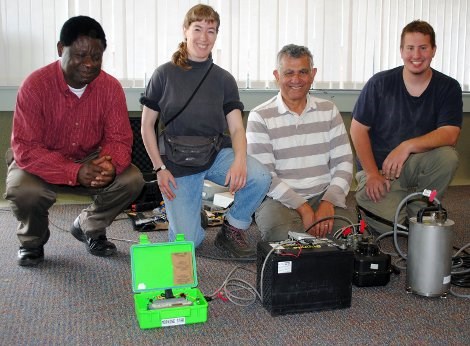NEWS RELEASE
ALGOMA UNIVERSITY
************************* Scientists to explore midcontinent rift in Northern Ontario
SAULT STE. MARIE, ON - (June 1) - Geoscientists from five American and Canadian universities are installing a series of seismograph stations in Minnesota, Wisconsin, and Ontario as a part of the SPREE (Superior Province Rifting EarthScope Experiment) Project, funded by the National Science Foundation (USA).
The seismometers will record earthquakes that occur locally, regionally, and throughout the world.
Scientists use the seismic waves from these earthquakes to produce high-resolution images of the Earth's interior. The goal of the project is to study a geologic feature called the Midcontinent Rift; a seismic event that threatened to break apart North America approximately a billion years ago.
Over a span of 20 million years, about 1.5 million cubic kilometers of volcanic rock (enough to fill up all of the Great Lakes over 66 times) was erupted or intruded into the earth's crust.
Many rifts break continents apart to form new oceans, but here, despite its size, the Midcontinent Rift failed to break apart the continent.
Scientists don't know why some rifts succeed, and others fail.
The subsurface structure of the Midcontinent Rift is still relatively unknown, and the data recorded by the seismometers to create images of the rift's structure deep below the surface will provide clues about why it started, how it grew, and why it failed. Over the next two weeks, Dr. Fiona Darbyshire (University of Quebec at Montreal), Miguel Merino (Northwestern University) and Dr. Ghassan Aleqabi (Washington University at St. Louis), will be installing the northeastern stations, which are scattered around the northern part of Lake Superior.
Dr. William Osei of the Department of Geography and Geology at Algoma University is collaborating on the project by providing a location to receive, test, and store the seismographic equipment. The seismograph stations will remain in place for about two-and-a-half years.
Each station is placed in an area far from sources of noise and vibration such as roads, railroads, and occupied buildings.
The seismometer itself is buried underground, and the electronics are powered by solar panels. This project is funded by EarthScope (www.earthscope.org) and represents a collaboration between Northwestern University, Washington University in St. Louis, the University of Minnesota, the University of Manitoba, and the University of Quebec at Montreal.
About Algoma University
Algoma University is committed to offering an undergraduate education experience unlike any university in Ontario, offering a wide variety of program options.
Algoma University also offers accelerated second degree programs in business administration in Brampton, and two degrees, including a Bachelor of Social Work, in Timmins.
As a partner with Shingwauk Kinoomaage Gamig, Algoma U is committed to respecting Anishinaabe knowledge and culture.
To learn more about Algoma University, visit www.algomau.ca
PHOTO CAPTION: L-R: Dr. William Osei (Algoma University), Dr. Fiona Darbyshire (University of Quebec at Montreal), Dr. Ghassan Aleqabi (Washington University at St. Louis), Miguel Merino (Northwestern University).
